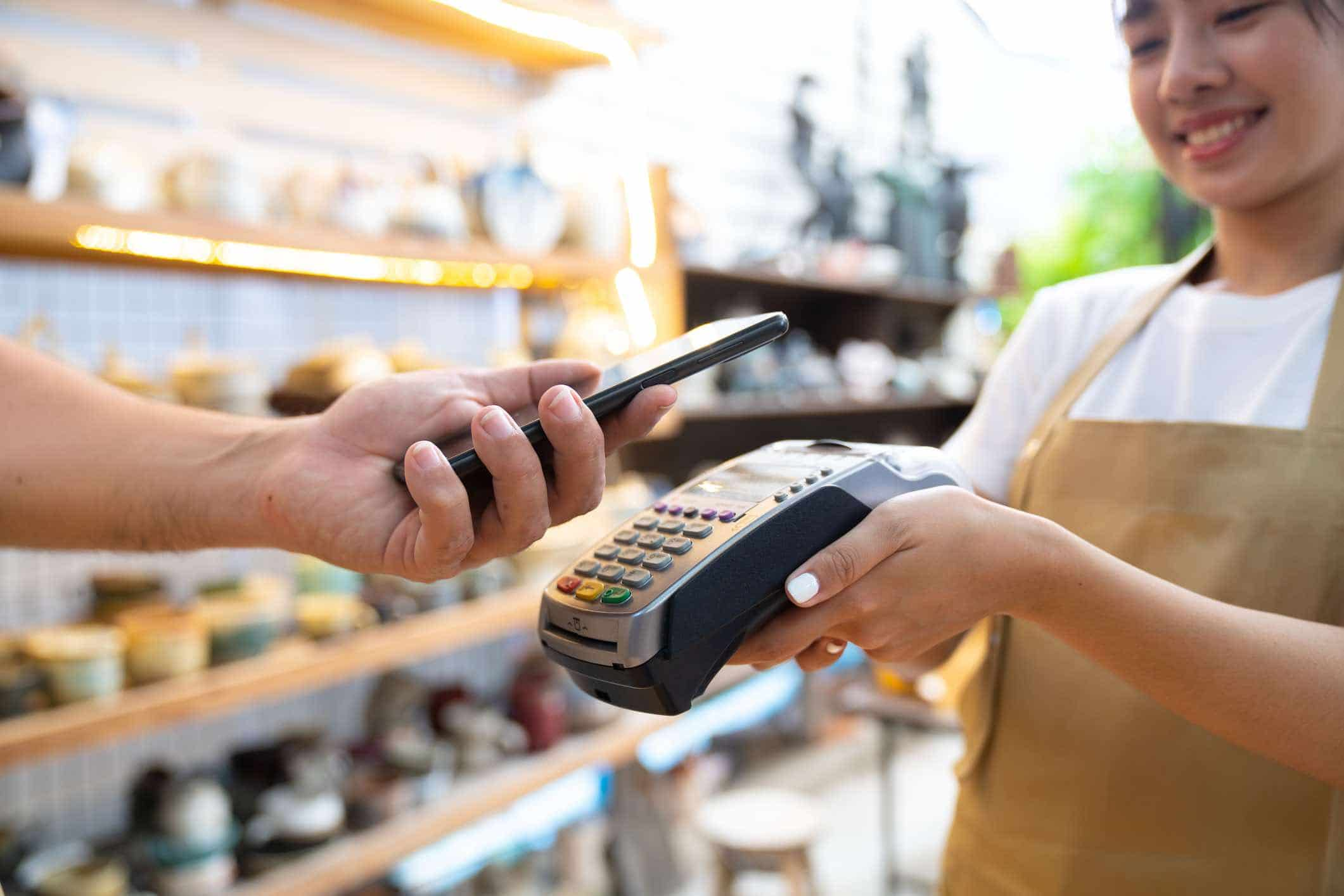Introduction
Welcome to the digital age, where advancements in technology have transformed the way we carry out our daily transactions. With the rise of contactless payment systems, mobile wallets, and online banking, a cashless society is becoming more and more prevalent. In a cashless society, physical cash is gradually being replaced by digital forms of payment. While this shift towards a cashless society comes with numerous advantages, it is essential to consider its impact on the economically disadvantaged.
A cashless society refers to a society in which electronic transactions, such as card payments, mobile payments, and online transfers, are the primary methods of exchange. This means that physical cash is no longer the predominant medium of transaction.
The advantages of a cashless society are evident. It offers convenience, security, and efficiency in conducting financial transactions. With digital transactions, there is no need to carry around bulky wallets or worry about the risk of losing cash. It also reduces the chances of becoming a victim of theft or counterfeit money. Moreover, digital payments enable seamless online shopping experiences, including quick and effortless checkout processes.
However, the transition to a cashless society raises concerns about its impact on the economically disadvantaged. This group includes individuals who have limited financial resources, lack access to banking services, or live in poverty. It is crucial to examine how this shift affects their ability to participate in the economy and access basic financial services.
In this article, we will explore the ways in which the economically disadvantaged are affected by a cashless society. We will examine the challenges they face in terms of financial exclusion, limited access to banking services, increased reliance on technology, and the marginalization of the unbanked population. Additionally, we will discuss the potential solutions and initiatives that can help mitigate these challenges and create a more inclusive financial environment.
Definition of a Cashless Society
A cashless society is a term used to describe a society in which electronic transactions are the primary means of financial exchange, with physical cash being replaced by digital forms of payment. In such a society, individuals rely on various electronic payment methods, such as credit or debit cards, mobile payment apps, and online transfers, to make purchases and conduct financial transactions.
In a cashless society, the use of physical currency becomes increasingly obsolete, as digital alternatives offer convenience, speed, and security. Instead of fumbling for cash or change, people can simply swipe a card or tap their smartphones to make a payment. This shift has been fueled by technological advancements in payment systems, the proliferation of smartphones, and the growth of online commerce.
One of the key characteristics of a cashless society is the prevalence of digital wallets or mobile payment applications. These applications, such as Apple Pay, Google Pay, or Samsung Pay, allow users to link their debit or credit cards to their smartphones and make contactless payments at various retailers. The rise of Near Field Communication (NFC) technology has made it possible for consumers to make payments by simply tapping their phones on compatible payment terminals.
Moreover, online banking and electronic fund transfers have become common in a cashless society. Individuals can transfer money between accounts, pay bills, and make online purchases without the need for physical cash. Online platforms and e-commerce websites have also made it easier for businesses to accept digital payments, further promoting the cashless trend.
It is important to note that a cashless society does not mean the complete elimination of physical cash. Cash will likely still be available for specific purposes, emergencies, or in certain situations where digital payment methods are unavailable or not accepted. However, the overall reliance on cash will diminish significantly in favor of digital alternatives.
While the transition to a cashless society offers many benefits, it also raises concerns and implications, especially for those who may face challenges in adapting to this evolving financial landscape. In the following sections, we will explore the advantages and disadvantages of a cashless society and specifically focus on its impact on the economically disadvantaged.
Advantages of a Cashless Society
The shift towards a cashless society brings numerous advantages that are transforming the way we conduct transactions and manage our finances. Here are some of the key benefits:
- Convenience: One of the primary advantages of a cashless society is convenience. With digital payment methods, individuals can make transactions quickly and easily. No more counting coins or searching for exact change. Payments can be made with a simple tap or a few clicks, saving time and effort.
- Enhanced security: Digital payments provide a higher level of security compared to carrying around cash. Physical currency can be lost, stolen, or counterfeited. In a cashless society, the risk of theft and fraud is significantly reduced. Advanced encryption and authentication methods protect sensitive financial data, ensuring the safety of transactions.
- Efficiency: Digital transactions are swift and efficient, allowing for faster processing times compared to cash transactions. Businesses benefit from streamlined checkout processes, reducing waiting times for customers. Additionally, digital records of transactions simplify accounting, making it easier to track expenses and manage finances.
- Easy tracking and budgeting: Digital payment methods enable individuals to track their expenses easily. Bank statements, mobile apps, and online banking provide detailed records of transactions, making it simpler to monitor spending habits and create budgets. This transparency helps individuals make more informed financial decisions and manage their money more effectively.
- Seamless online shopping: A cashless society facilitates online shopping. E-commerce platforms offer a variety of payment options, making it convenient for consumers to make purchases from the comfort of their homes. Digital wallets and stored payment information simplify the checkout process, providing a seamless online shopping experience.
Furthermore, the transition to a cashless society promotes financial inclusion. It enables individuals who may not have access to traditional banking services to participate in the formal economy. Mobile banking and digital payment apps allow individuals to open accounts, conduct transactions, and access financial services without the need for a physical bank branch.
In the following sections, we will explore the disadvantages of a cashless society and delve into how these advantages may have unintended consequences for the economically disadvantaged.
Disadvantages of a Cashless Society
While the move towards a cashless society brings several benefits, it is important to consider the potential disadvantages and challenges that come with this transition. Here are some of the key drawbacks:
- Exclusion of the unbanked population: A cashless society can lead to the exclusion of individuals who do not have access to traditional banking services. This includes those who are unbanked or underbanked, such as low-income individuals, immigrants, and marginalized communities. Without access to banking facilities, these individuals may face difficulties in participating fully in the financial ecosystem.
- Technological dependence: A cashless society relies heavily on technology infrastructure, such as internet connectivity and electronic payment systems. However, not everyone has consistent access to these resources, especially in rural or underdeveloped areas. Technological failures and system outages can disrupt transactions and leave individuals unable to make payments.
- Privacy concerns: Digital transactions involve the collection and storage of personal information, raising concerns about data privacy and security. While stringent measures are in place to protect sensitive data, there is always a risk of data breaches or unauthorized access to personal information. This can compromise individuals’ financial privacy and expose them to fraudulent activities.
- Digital divide: The transition to a cashless society can deepen the divide between those who have access to digital technologies and those who do not. The economically disadvantaged, including older adults or individuals with limited technological literacy, may struggle to adapt to digital payment systems. This can further isolate and marginalize these groups in a society that is becoming increasingly reliant on digital transactions.
- Vulnerability to cyber threats: As digital transactions become more prevalent, the risk of cybercriminals targeting individuals and organizations also increases. Malware, phishing scams, and identity theft are significant concerns in a cashless society. Individuals must remain vigilant and take necessary precautions to protect their personal and financial information from cyber threats.
Furthermore, a cashless society can have unintended consequences for the informal economy. Cash transactions often play a significant role in informal sectors, such as street vendors, small businesses, and under-the-table transactions. These individuals may face challenges in adapting to digital payment methods and may be excluded from the formal economy.
In the next sections, we will explore how the economically disadvantaged are specifically affected by a cashless society and discuss potential solutions to address these challenges.
Overview of the Economically Disadvantaged
Before we delve into how the economically disadvantaged are affected by a cashless society, it is important to have an understanding of who is considered part of this group. The economically disadvantaged encompass individuals who lack the financial resources or access to opportunities that are necessary for economic well-being. This category includes low-income individuals, those living in poverty, and marginalized communities.
Low-income individuals often struggle to meet their basic needs due to limited financial resources. They have a lower income compared to the average population, making it challenging to afford necessities such as housing, food, education, and healthcare. These individuals may rely heavily on government assistance programs, making financial management even more crucial.
Those living in poverty face even more significant economic challenges. Poverty is a multidimensional issue that affects various aspects of individuals’ lives, including education, health, and overall quality of life. With limited financial means, individuals and families in poverty often lack access to essential services and are at a higher risk of experiencing hardships.
Marginalized communities, including racial and ethnic minorities, refugees, and immigrants, also fall within the economically disadvantaged group. These communities may face systemic barriers and disparities that impede their economic advancement. Limited access to education, discriminatory practices, and exclusion from formal financial systems can hinder their ability to improve their economic situation.
It is important to recognize that the economically disadvantaged group is not homogenous, and the challenges they face can vary from one individual to another. However, they all share a common struggle in navigating financial hardships and seeking pathways towards economic stability.
With this understanding of the economically disadvantaged, we can now explore how the shift towards a cashless society affects this group and the potential implications it may have on their financial inclusion and well-being.
How the Economically Disadvantaged are Affected by a Cashless Society
The transition to a cashless society has both positive and negative implications for the economically disadvantaged. While digital payment systems offer convenience and security, they also present challenges that can disproportionately affect this vulnerable group. Let’s explore some of the ways in which the economically disadvantaged are affected:
- Financial exclusion: The economically disadvantaged are at a higher risk of financial exclusion in a cashless society. Without access to traditional banking services or the necessary identification documents required for opening bank accounts, individuals may be unable to participate fully in digital transactions. This exclusion further perpetuates the cycle of poverty and limits their ability to access essential services and resources.
- Limited access to banking services: Many individuals in the economically disadvantaged group do not have access to banking services, such as debit or credit cards, which are vital for participating in a cashless society. This lack of access restricts their ability to make digital payments, leaving them reliant on cash transactions or alternative, often more expensive, financial services.
- Increased reliance on technology: The shift to a cashless society assumes individuals have access to and are proficient in using digital technologies. However, the economically disadvantaged may face challenges due to limited access to devices, unreliable internet connectivity, or unfamiliarity with technology. This reliance on technology for financial transactions can further marginalize those already facing economic disadvantages.
- Marginalization of the unbanked population: The economically disadvantaged who are unbanked or underbanked may be further marginalized in a cashless society. As digital payment methods become prevalent and cash transactions decrease, those without access to banking services find it increasingly difficult to engage in economic activities, make purchases, or receive payments. This digital divide can deepen existing inequalities and limit opportunities for financial growth.
- Impact on the informal economy: Cash transactions often play a significant role in informal sectors, providing income opportunities for the economically disadvantaged. The shift towards a cashless society can disrupt these informal economies, making it challenging for individuals to conduct business or receive payments in a cashless environment. This can lead to income loss, decreased economic sustainability, and limited opportunities for upward mobility.
It is important to recognize these challenges and work towards creating solutions that address the specific needs of the economically disadvantaged. In the next section, we will explore potential initiatives and solutions to mitigate these challenges and promote financial inclusion in a cashless society.
Financial Exclusion
One of the significant challenges the economically disadvantaged face in a cashless society is financial exclusion. Financial exclusion refers to the inability or limited access of individuals to mainstream financial services and products, such as banking, credit, and insurance. This exclusion exacerbates the existing inequalities and hinders the economic advancement of this vulnerable group.
In a cashless society, traditional banking services play a crucial role in participating fully in the digital economy. However, many individuals in the economically disadvantaged group do not have access to bank accounts or the necessary identification documents required to open one. Without a bank account, they lack the fundamental infrastructure to engage in digital transactions and benefit from the convenience and security offered by digital payment systems.
The financially excluded often resort to cash transactions or alternative financial services, such as payday loans, check cashing services, or pawnshops. These services tend to be costlier, placing a disproportionate burden on those who can least afford it. The additional fees and high-interest rates associated with these services can further entrench individuals in a cycle of debt and financial instability.
Lack of access to banking services also restricts the economically disadvantaged from building credit history, accessing loans for education or housing, and saving for the future. It affects their ability to plan, invest, and build financial security, perpetuating the cycle of poverty.
Efforts to address financial exclusion include promoting financial literacy and providing resources for individuals to navigate the banking system. Community-based organizations, government initiatives, and non-profit organizations can play a crucial role in providing financial education and guidance to the economically disadvantaged, helping them understand and access banking services.
Technology also plays a significant role in addressing financial exclusion. Mobile banking and digital payment platforms can provide alternatives for the unbanked and underbanked individuals. These platforms allow individuals to open accounts, conduct transactions, and access basic financial services without relying solely on traditional bank branches. Moreover, initiatives targeting the development of digital identification systems can help overcome barriers that hinder access to banking services for the economically disadvantaged.
Addressing the issue of financial exclusion requires collaboration between governments, financial institutions, and community organizations. It necessitates the development of inclusive policies, the provision of affordable banking services, and the creation of support networks that empower the economically disadvantaged to navigate the financial system and actively participate in a cashless society.
Limited Access to Banking Services
Another significant challenge faced by the economically disadvantaged in a cashless society is limited access to banking services. Access to banking services, such as having a bank account or debit card, is essential for individuals to participate fully in the digital economy and benefit from the convenience and security offered by digital payment systems.
Many individuals in the economically disadvantaged group do not have access to traditional banking services due to various reasons. Some may live in remote or underprivileged areas where physical bank branches are scarce. This lack of proximity to banking infrastructure makes it difficult for individuals to open and maintain bank accounts. Furthermore, the cost associated with maintaining a bank account, such as minimum balance requirements and transaction fees, can be prohibitive for those with limited financial resources.
Additionally, the financially disadvantaged may face challenges in meeting the strict identification requirements imposed by financial institutions to open a bank account. Lack of proper identification documents or a stable address can create barriers for individuals to access banking services and engage in digital transactions.
Without access to banking services, individuals often rely on alternative financial services, such as check cashing or remittance centers, which tend to charge higher fees and offer limited financial products compared to traditional banks. This further exacerbates the financial strain on the economically disadvantaged, making it more challenging to save, build credit, and access affordable financial resources.
To address the issue of limited access to banking services, financial institutions and governments must work together to develop inclusive banking solutions. This can include initiatives such as mobile banking, which leverages the widespread use of mobile phones to provide banking services to individuals who may not have access to physical bank branches.
Furthermore, partnerships between traditional financial institutions and community-based organizations can help establish financial access points that provide basic banking services to the economically disadvantaged. These access points can be set up in community centers, educational institutions, or other convenient locations, making it easier for individuals to access banking services and receive financial education.
Government policies also play a significant role in promoting greater access to banking services. This can include measures to reduce the cost of banking services, relax identification requirements, and encourage financial institutions to serve underserved communities. Additionally, financial literacy programs can equip individuals with the knowledge and skills necessary to navigate the banking system and make informed financial decisions.
By addressing the issue of limited access to banking services, society can take steps towards creating a more inclusive financial ecosystem that empowers the economically disadvantaged to participate more equitably in the cashless society.
Increased Reliance on Technology
The shift towards a cashless society brings an increased reliance on technology, which poses challenges for the economically disadvantaged. While digital payment systems offer convenience and efficiency, individuals in this group may face difficulties in adapting to and accessing these technologies.
In a cashless society, the ability to engage in financial transactions requires access to digital devices such as smartphones or computers, as well as reliable internet connectivity. However, the economically disadvantaged often face barriers to accessing these resources due to financial constraints or limited infrastructure, particularly in rural or underserved areas. This digital divide hinders their ability to participate fully in the digital economy.
Moreover, technology literacy plays a significant role in successfully navigating digital payment systems. Understanding how to use mobile banking apps, set up online accounts, and securely conduct transactions is crucial. However, many individuals in the economically disadvantaged group may have limited familiarity or confidence in using digital technologies. This can create a significant barrier to their participation in a cashless society.
Furthermore, individuals who rely on cash transactions and have limited access to digital payment methods may face challenges when interacting with businesses and service providers that only accept digital payments. This can lead to exclusion and limited access to goods and services, further exacerbating the economic disadvantages they face.
To address these challenges, efforts must be made to enhance digital literacy among the economically disadvantaged. Educational initiatives, community-based workshops, and partnerships with technology companies can help individuals develop the necessary skills to effectively use digital payment systems. Governments and organizations can also provide resources such as affordable or subsidized smartphones, internet connectivity, and digital training programs to bridge the digital divide.
In addition, businesses and financial institutions should consider providing alternative payment options that cater to individuals who may not have access to digital payment methods. Accepting cash or implementing alternative payment schemes, such as prepaid cards or vouchers, can ensure that the economically disadvantaged can still participate in economic activities despite a cashless shift.
Ultimately, addressing the increased reliance on technology requires a multidimensional approach. By taking into account the specific needs and challenges faced by the economically disadvantaged, society can work towards creating a more inclusive cashless society that minimizes the negative impact of technological advancements and maximizes the benefits for all members of the population.
Marginalization of the Unbanked Population
A significant consequence of the shift towards a cashless society is the marginalization of the unbanked population. The unbanked refers to individuals who do not have access to traditional banking services or do not hold a bank account. This exclusion from the financial mainstream can further deepen the economic disparities faced by this vulnerable group.
In a cashless society, digital payment methods and online banking become the primary means of conducting financial transactions. However, without access to banking services, the unbanked population is unable to fully participate in the formal economy. They face barriers when making purchases, paying bills, or accessing financial services that are commonly accessed through digital platforms.
The lack of a bank account limits the unbanked population’s ability to receive and make digital payments, access credit facilities, or save money. This exclusion from basic financial services hinders their financial stability and prevents opportunities for economic growth and upward mobility.
Financial institutions often require valid identification documents, proof of address, and a minimum income threshold, making it challenging for the unbanked to open and maintain bank accounts. As a result, these individuals often rely on cash transactions and informal financial systems, which may not offer the same level of security, convenience, or access to resources as digital payment methods.
The marginalization of the unbanked population perpetuates a cycle of economic disadvantage and limited opportunities for financial inclusion. It hinders their access to credit and financial resources necessary for business ventures, education, or personal development. Furthermore, the unbanked may face difficulty in receiving direct financial assistance, such as government aid or employer payments, which are increasingly being disbursed digitally.
To address the marginalization of the unbanked population, it is crucial to implement initiatives that promote financial inclusion. This includes expanding access to basic banking services through the establishment of banking branches or access points in underserved areas. Simplified identification requirements, reduced fees, and educational programs can also facilitate the inclusion of the unbanked population.
Partnerships between financial institutions, government agencies, and non-profit organizations can play a crucial role in providing financial education, promoting financial literacy, and helping the unbanked understand the benefits of digital payment systems. Digital initiatives like mobile banking and financial inclusion apps can also provide alternative avenues for the unbanked to access financial services and participate in the digital economy.
Addressing the marginalization of the unbanked population requires collaboration and targeted efforts from multiple stakeholders. By implementing inclusive policies and providing support to the unbanked, society can work towards creating a cashless society that leaves no one behind.
Impact on the Informal Economy
The transition towards a cashless society can have a significant impact on the informal economy, which comprises unregulated economic activities and transactions that often occur outside the purview of formal taxation and regulation. Cash transactions play a significant role in the informal economy, and the move towards digital payments can disrupt this sector and have consequences for individuals who depend on it.
In the informal economy, cash transactions are prevalent due to their anonymity, flexibility, and simplicity. This includes street vendors, small businesses, daily wage laborers, and other individuals who rely on cash exchanges to sustain their livelihoods. However, in a cashless society, where digital payment options are favored, these individuals may face challenges in conducting business or receiving payments from customers who prefer digital transactions.
With the increasing popularity of digital payment systems, individuals engaged in the informal economy may need to invest in digital infrastructure or access to online platforms to continue conducting business. This not only requires financial resources but also technical knowledge to operate digital payment tools or develop an online presence. The lack of familiarity with these technologies can further marginalize individuals in the informal economy, restricting their ability to compete and access customers.
Furthermore, the informal economy often provides opportunities for individuals who may face barriers in the formal job market, such as those without formal education or work permits. The shift towards a cashless society may limit these individuals’ ability to engage in income-generating activities, potentially leading to unemployment or increased poverty levels.
However, it is important to note that the impact on the informal economy can vary depending on the context and the specific industry. Certain sectors, such as those involving high-value transactions or international trade, may already have integrated digital payment systems as part of their operations. In contrast, sectors heavily reliant on small-scale cash transactions, such as street vendors or informal markets, may face more significant challenges in adapting to the cashless transition.
In order to address the impact on the informal economy, policymakers and stakeholders should consider measures to support individuals and businesses in this sector. This can include providing financial assistance or resources to help them transition to digital payment systems, fostering partnerships between digital payment providers and the informal sector, and creating platforms or marketplaces that enable informal businesses to engage in digital transactions more easily.
Ensuring that the transition to a cashless society does not marginalize the informal economy is crucial for maintaining economic inclusivity. Recognizing the specific challenges faced by individuals in the informal sector and implementing targeted measures can help promote a fair and equitable economy for all.
Potential Solutions and Initiatives
To address the challenges faced by the economically disadvantaged in a cashless society, several solutions and initiatives can help promote financial inclusion and equal access to digital payment systems. Here are some potential interventions that can make a difference:
- Financial literacy and education: Providing financial literacy programs and educational resources that specifically target the economically disadvantaged can empower individuals with the knowledge and skills necessary to navigate digital payment systems. These programs can offer guidance on managing personal finances, understanding the benefits of digital transactions, and safeguarding against potential risks.
- Mobile banking and digital wallets: Promoting the use of mobile banking applications and digital wallets as alternatives to traditional banking can offer easier access to financial services for the unbanked and underbanked population. Mobile banking apps can allow individuals to check balances, transfer money, and make payments using their smartphones, bypassing the need for a physical bank branch.
- Reduced barriers to banking: To tackle financial exclusion, financial institutions should reassess their requirements for opening bank accounts. Simplifying identification processes, reducing minimum balance requirements, and offering low-cost or no-fee accounts can help make banking services more accessible to the economically disadvantaged.
- Partnerships with community organizations: Collaborating with community organizations and non-profit groups can help reach out to the economically disadvantaged and provide them with resources and support. Offering financial counseling, assistance with documentation requirements, and technology training can empower individuals to overcome barriers and access digital payment systems.
- Public-private partnerships: Governments and financial institutions can establish partnerships to develop affordable and accessible financial products tailored to the needs of the economically disadvantaged. This includes low-cost banking services, prepaid cards, or digital payment schemes that cater specifically to individuals who may not have access to traditional banking services.
- Investment in infrastructure: Improving digital infrastructure, particularly in rural and underserved areas, can help bridge the digital divide. This includes expanding internet connectivity, fostering access to affordable devices, and setting up digital access points in communities where traditional banking services are scarce.
- Regulatory support: Governments can play a crucial role in creating a supportive regulatory environment that encourages financial inclusion. This includes implementing policies that protect the rights of the economically disadvantaged, encourage financial institutions to provide inclusive services, and foster innovation in digital payment systems.
These potential solutions and initiatives require collaboration between governments, financial institutions, technology providers, and community organizations. By working together, society can create an inclusive financial ecosystem that ensures the economically disadvantaged have equal opportunities to access and benefit from the advantages of a cashless society.
Conclusion
The transition towards a cashless society presents enormous opportunities for convenience, security, and efficiency in financial transactions. However, it is imperative to recognize that this shift also brings about challenges for the economically disadvantaged, further exacerbating existing inequalities within our society.
In this article, we have explored the definition of a cashless society and examined the advantages and disadvantages it presents. We have delved into the specific implications for the economically disadvantaged, including financial exclusion, limited access to banking services, increased reliance on technology, marginalization of the unbanked population, and the impact on the informal economy.
While the challenges are significant, there are potential solutions and initiatives that can address these issues and promote a more inclusive cashless society. Financial literacy programs, mobile banking, reduced barriers to banking, partnerships with community organizations, investment in infrastructure, and supportive regulatory measures are among the potential interventions that can empower the economically disadvantaged, enhance their access to financial services, and bridge the digital divide.
It is crucial that governments, financial institutions, technology providers, and community organizations collaborate and invest efforts to ensure that the transition to a cashless society is inclusive and does not leave anyone behind. By implementing these solutions, we can create a financial ecosystem that provides equal opportunities for the economically disadvantaged to participate in the digital economy and improve their financial well-being.
As we navigate the path towards a cashless society, it is essential to keep social equity and inclusivity at the forefront. By working together and addressing the challenges faced by the economically disadvantaged, we can truly harness the benefits of a cashless society and create a more just and equitable financial landscape for all members of society.

























